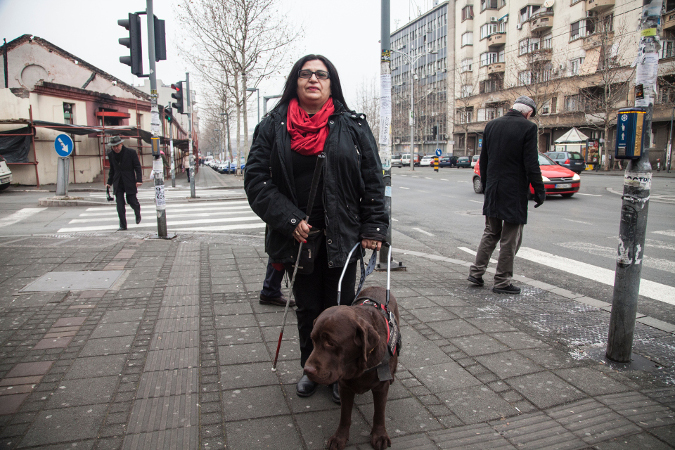From where I stand: “Our rights are still not recognized”
Vesna Nestorovic, 52, is the founder of the “White Cane” Association of the Blind and Visually Impaired, an author and the President of an Aikido Association for persons with disabilities in Serbia. Her sight started deteriorating in childhood and she became blind at age 36. In her strife to gain independence of movement, Nestorovic became the first person in Serbia to use a trained guide dog. She and her association launched a public campaign where they collected funds to bring Astor – Nestorovic’s current guide dog from Sofia, Bulgaria. White Cane also successfully lobbied for the city legislation to change to accept guide dogs into public spaces. The law on guide dogs was adopted in March 2015, largely due to Nestorovic and White Cane’s lobbying efforts.Date:

It started during the war. Belgrade was bombed. I could not stand it, both mentally and physically, it was a very tragic time for all of us. During the war, my intraocular pressure spiked and I had to undergo three surgeries. Facing the fact that my sight would not come back was one of the biggest challenges, especially when it came to telling my family.
My life was split in two parts. The first is when I could see, when I went to university, gave birth to my son, when I had a successful career as a journalist. And then the second part is when I sold my apartment to pay for the eye surgeries, when I lost my sight completely and along with that, many other things I had owned. I found myself in the dark. I realized that in Serbia there was no support for people with disabilities. I never depended on anybody’s help. That was the biggest problem. It was more difficult for me to ask someone for help than to face the fact that I was blind.
My mother did not know what to do when I turned blind. I still remember the first day when I sat the table and my mother took my hand, moved it and placed it on a piece of bread. We never discussed my blindness. She never wanted to ask me questions, I never wanted to tell her what it was like. She passed away nine years after I turned blind and she never knew how I felt about it. On paper, we have great rights and we know our rights. But on the street, these rights are still not recognized. There is still violence in the minds of people, which is a legacy of the war, which has been with us for generations. I remember one day the driver of the bus I took told me that he would call the police if I don’t leave the bus with my dog. I refused to leave and a woman spat on me. That’s when I told myself ‘OK I haven’t done enough. If they spit on me, I have to launch another public campaign.’ My personal mantra is ‘Let’s take the ‘S’ out of ‘Slepa’ [an effective play on words with ‘slepa’ meaning ‘blind’ in Serbian, whereas “lepa” means ‘beautiful’]. I can’t be inactive. I didn’t go to school to study how to be inactive. I was always a successful woman and I will continue being so. Before I turned blind I was doing so many things in the dark. We had no electricity and I even took showers in pitch darkness. I walked around and found things in the dark. I hugged the people I loved and I closed my eyes. I had already lived part of my life in the dark, why stop now?”
Nestorovic and White Cane are engaged in several campaigns aimed at social inclusion of the blind and people with visual impairment. Since its establishment in 2003, one of White Cane’s goals is to train Orientation and Mobility instructors, a new specialty in Serbia. Nestorovic and her colleagues in the association are involved in a new campaign where they are collecting funds to launch a first training facility for guide dogs in Serbia. Ms. Nestorovic’s story is related to Sustainable Development Goal (SDG) 10 that focuses on empowering and promoting the social, economic and political inclusion of all, irrespective of age, sex, disability, race, ethnicity, origin, religion or economic or other status. Her story also is related to SDG 5 with a target on ensuring women’s full and effective participation and equal opportunities for leadership at all levels of decision-making in political, economic and public life.
Read more stories in the “From where I stand...” editorial series.